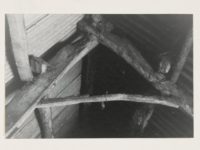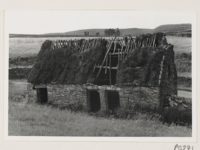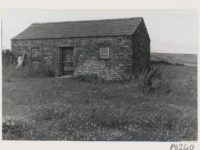The fieldworkers also recorded the appearance and function of farm buildings, paying special attention to barns and cow-sheds. As they travelled the country, they could already see changes in the materials used to construct these buildings and their state of repair. They preserved these buildings by taking photographs, paying particular attention to rarer details such as cruck framework and thatched roofs.

‘Club Nook Cottage: Crucks’ (LAVC/PHO/P0348) by Werner Kissling 1967
Crucks are curved timbers that support the structure’s roof.

‘Thatched Cow Barn’ (LAVC/PHO/P0271) by Werner Kissling Near Hurst, North Yorkshire, 1963.

‘Kilnsey Hall’ (LAVC/PHO/P0294) by Stewart Sanderson
Wharfedale, 1967. The old manor house was in use as a barn and this was thought to be the case for around 150 years prior to this photograph being taken.

‘Cow Byre at Hillary Farm’ (LAVC/PHO/P0260) by Werner Kissling 1967 This stone cow shed was built in 1881.
The fieldworkers and informants also recorded the appearance and layout of these humble buildings through illustrations.

llustration of thatched cow shed, Farningham, Kent, 1952. Recorded on p5 of Response Book.
(LAVC/SED/2/2/35/2/10)

Illustration of cow byre interior, Borrowby, North Yorkshire, 1951. Recorded on p3 of Response Book.
(LAVC/SED/2/2/6/9/10)
In a recording made by fieldworker Stanley Ellis in 1955, Bill Ewing describes the layout of his farm buildings and the design of his tee-fall byre (lean-to cow-shed) with loft above in Strickland, Cumbria.
Listen here
'Bill Ewing, interviewed by Stanley Ellis in 1955' ( LAVC/SRE/D/2/D98 )
A transcription for this audio can be found (here)
If you would like to hear examples of the dialect collected, the following recording features Harry Corfield in Diddlebury, Shropshire, talking about his farm buildings. Harry describes the wain-house (cart-shed). He also describes the layout of his cow-shed, including the boosy (trough), cratch (hay-rack), stelch (tethering-stake), bing (gangway in front of cow-stall from which cows are fed) and tallet (hay-loft).
Listen here
‘Harry Corfield in Diddlebury, Shropshire, talking about his farm buildings’ (LAVC/SRE/A729r)
Harry describes the wain-house (cart-shed). He also describes the layout of his cow-shed, including the boosy (trough), cratch (hay-rack), stelch (tethering-stake), bing (gangway in front of cow-stall from which cows are fed) and tallet (hay-loft).
A transcription for this audio can be found (here)
How do you say?

The fieldworkers also recorded the range of dialect words used to describe cow-sheds.
‘SED Word Map: Cowhouse’ (LAVC/PHO/S015)
The fieldworkers also recorded the range of dialect words used to describe cow-sheds. They recorded 35 different words in total, including byre, beast-house, cow-house, hovel, mistall, shippon and skeeling. There were six different terms used in Yorkshire alone. This dialect map shows where these different terms were recorded:
At least five different terms used for calling in the cows were also recorded. These included hofe in Northumberland and how in northern Cumbria and the Isle of Man. Cush or cush-hope was also widely used in northern counties, and hope was used in a range of locations in the north and south of the country.



